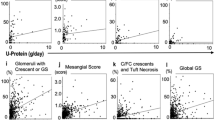Abstract
Glomerular hypertrophy has been suggested to be an important factor in the pathogenesis of focal glomerular sclerosis. The aim of the present study was to analyse retrospectively the renal biopsies of 58 children (0.2–16.1 years of age) with different types of the nephrotic syndrome, minimal change nephrotic syndrome (MCNS), diffuse mesangial proliferation (DMP) and focal segmental glomerulosclerosis (FSGS). Glomerular surface area was measured and glomerular volume was calculated and related to steroid responsiveness and to renal function, measured by clearances of inulin and para-aminohippuric acid. Glomerular volume correlated with body surface area (BSA) and age. Because of this, patients with FSGS and DMP were matched according to BSA and age, with corresponding MCNS patients. Glomerular volumes of FSGS and DMP patients were significantly larger than those of MCNS patients. In the MCNS patients, significant correlations were found between glomerular volumes and glomerular filtration rate and effective renal plasma flow. Steroid-dependent and steroid-resistant patients showed larger glomeruli than the steroid-responsive children. We suggest that hyperfiltration and hyperperfusion, among other factors, may contribute to glomerular hypertrophy, mesangial proliferation and glomerulosclerosis.
Similar content being viewed by others
References
Habib R, Kleinknecht C (1971) The primary nephrotic syndrome of childhood: classification and clinicopathologic study of 406 cases. Pathol Annu 6: 417–474
Churg J, Habib R, White RHR (1970) Pathology of the nephrotic syndrome in children. Lancet I: 1299–1302
White RHR, Glasgow EF, Mills RJ (1970) Clinicopathological study of nephrotic syndrome in childhood. Lancet I: 1353–1359
International Study of Kidney Disease in Children (1981) Primary nephrotic syndrome in children: clinical significance of histopathologic variants of minimal change and of diffuse mesangial hypercellularity. Kidney Int 20: 765–771
Garin EH, Donnelly WH, Geary D, Richard GA (1983) Nephrotic syndrome and diffuse mesangial proliferative glomerulonephritis in children. Am J Dis Child 137: 109–113
Waldherr R, Gubler MC, Levy M, Broyer M, Habib R (1978) The significance of pure diffuse mesangial proliferation in idiopathic nephrotic syndrome. Clin Nephrol 10: 171–179
Habib R, Churg J (1984) Mihimal change disease, mesangial proliferative glomerulonephritis and focal sclerosis: individual entities or a spectrum of disease? In: Robinson Roscoe R (ed) Nephrology, vol I. Springer, New York Berlin Heidelberg, pp 634–644
Tejani A (1985) Morphological transition in minimal change nephrotic syndrome. Nephron 39: 157–159
Fogo A, Yoshida Y, Ichikawa I, Glick AD (1988) Hypertrophic glomeruli and possible relationship to glomerular sclerosis. Lab Invest 58: 31A
Yoshida Y, Fogo A, Ichikawa I (1989) Glomerular hemodynamic changes vs. hypertrophy in experimental glomerular sclerosis. Kidney Int 35: 654–660
Yoshida Y, Kawamura T, Ikoma M, Fogo A, Ichikawa I (1989) Effects of antihypertensive drugs on glomerular morphology. Kidney Int 36: 626–635
Fries JWU, Sandstrom DJ, Meyer TW, Rennke HG (1989) Glomerular hypertrophy and epithelial cell injury modulate progressive glomerulosclerosis in the rat. Lab Invest 60: 205–218
El-Khatib MT, Becker GJ, Kincaid-Smith PS (1987) Morphometric aspects of reflux nephropathy. Kidney Int 32: 261–266
Morita M, Yoshiara S, White RHR, Raafat F (1990) The glomerular changes in children with reflux nephropaty. J Pathol 162: 245–253
Bhathena DB, Julian BA, McMorrow RG, Baehler RW (1985) Focal sclerosis of hypertrophied glomeruli in solitary functioning kidneys of humans. Am J Kidney Dis 5: 226–232
Østerby R, Gundersen HJG (1975) Glomerular size and structure in diabetes mellitus. Diabetologia 11: 225–229
Fogo A, Hawkins EP, Berry PL, Glick AD, Chiang ML, MacDonell RC, Ichikawa I (1990) Glomerular hypertrophy in minimal change disease predicts subsequent progression to focal glomerular sclerosis. Kidney Int 38: 115–123
Task force on blood pressure control in children (1977) Report of the task force on blood pressure control in children. Pediatrics 59: 797–820
Weibel ER (1979) Point counting using coherent test systems. In: Weibel ER (ed) Stereological methods. 1 Practical methods for biological morphometry. Academic Press, London, pp 101–161
Berg U, Bohlin A-B (1982) Renal hemodynamics in minimal change nephrotic syndrome in childhood. Int J Pediatr Nephrol 3: 187–192
Jereb B, Aperia A, Berg U, Broberger O, Båryd I (1973) Renal function in long-term survivors after treatment for nephroblastoma. Acta Paediatr Scand 62: 577–584
McLachlan MSF, Guthrie JC, Anderson CK, Fulker MJ (1977) Vascular and glomerular changes in the ageing kidney. J Pathol 121: 65–78
Ellis EN, Mauer SM, Sutherland DER, Steffes MW (1989) Glomerular capillary morphology in normal humans. Lab Invest 60: 231–236
Marcussen N, Olsen TS (1990) Atubular glomeruli in patients with chronic pyelonephritis. Lab Invest 62: 467–473
Yoshikawa N, Cameron AH, White RHR (1981) Glomerular morphometry I: nephrotic syndrome in childhood. Histopathology 5: 239–249
Steffes MW, Brown DM, Mauer SM (1978) Diabetic glomerulopathy following unilateral nephrectomy in the rat. Diabetes 27: 35–41
Hirose K, Tsuchida H, Østerby R, Gundersen HJG (1980) A strong correlation between glomerular filtration rate and filtration surface in diabetic kidney function. Lab Invest 43: 434–437
Seyer-Hansen K, Hansen J, Gundersen HJG (1980) Renal hypertrophy in experimental diabetes. Diabetologia 18: 501–505
Fogo A, Ichikawa I (1991) Evidence for a pathogenic linkage between glomerular hypertrophy and sclerosis. Am J Kidney Dis 17: 666–669
Woolf AS, Fine LG (1991) Do glomerular hemodynamic adaptations influence the progression of human renal disease? Pediatr Nephrol 5: 88–93
Brodehl J (1991) The treatment of minimal change nephrotic syndrome: lessons learned from multicentre co-operative studies. Eur J Pediatr 150: 380–387
Author information
Authors and Affiliations
Rights and permissions
About this article
Cite this article
Nyberg, E., Bohman, S.O. & Berg, U. Glomerular volume and renal function in children with different types of the nephrotic syndrome. Pediatr Nephrol 8, 285–289 (1994). https://doi.org/10.1007/BF00866336
Received:
Revised:
Accepted:
Issue Date:
DOI: https://doi.org/10.1007/BF00866336




